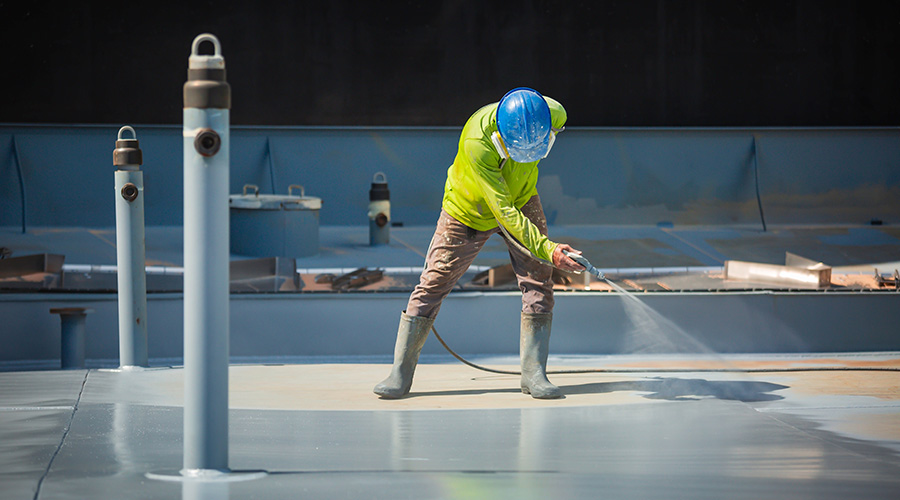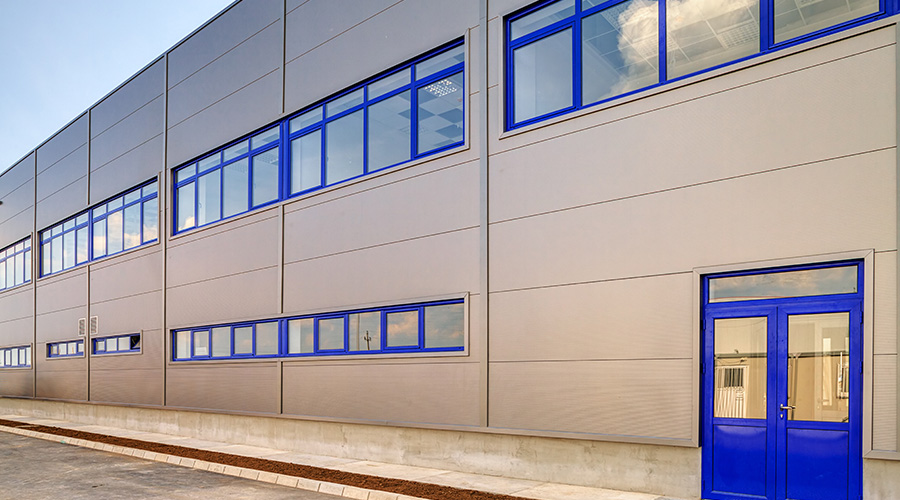Preventing Water Woes
A closer look at the roles of exterior coatings, maintenance, and wall-system design in developing a comprehensive waterproofing strategy
Building materials that make up a building’s exterior walls are designed with numerous performance characteristics. Two of the most critical of these characteristics are aesthetics and water resistance. The building’s exterior should look good, and it should keep the exterior environment out while providing a healthy, comfortable interior environment for occupants.
A critical goal in keeping the exterior environment out is providing adequate resistance to water infiltration. In addition to being a nuisance, water infiltration can have serious adverse effects on the building and potentially on the health and safety of occupants. Even with a building envelope that has been properly designed to resist water penetration, proper maintenance of building materials requires constant vigilance.
Water that becomes evident inside a building often is discovered quickly and remedied before much wall damage can occur. But water that lingers within the wall assembly but does not become evident inside has a greater chance of going undetected and causing greater concealed damage. Understanding the ways that a cladding system works and the required maintenance procedures can help maintenance and engineering personnel prolong the useful service life of exterior walls systems and materials.
Wall-system Design
To determine the appropriate maintenance needs for an exterior wall, managers and front-line technicians must understand the way a wall was designed to resist water infiltration. Generally, exterior wall systems are designed to keep water out in four ways.
The first approach can be referred to as a surface-sealed system, in which the wall materials are expected to repel all water at the exterior surface. Some curtain-wall systems, as well as early generations of exterior insulation and finish systems (EIFS), are designed as surface-sealed systems.
Sealants are typically an important part of these systems to provide primary watertightness at joints within the system and at interfaces with adjoining materials and components. If no redundant drainage system is built in, any breach of the exterior surface could mean direct leakage into the wall assembly and interior spaces.
The second approach to preventing water infiltration is a barrier system, in which the exterior wall allows some water to be absorbed into the cladding material but not to the extent that water passes through to the interior. Examples of this type of wall include solid, multi-wythe brick masonry or concrete walls. These materials absorb water but are thick enough to prevent water from passing completely through the wall assembly. Once the source of moisture is removed, the water that is absorbed evaporates at the exterior surface.
The third approach is a drainage system, in which it is expected that some water will infiltrate past the exterior cladding materials, but most will be resisted at the exterior surface. Water that does infiltrate then flows downward to a collection point and outside. A cavity — continuous or intermittent slots — often is provided behind the exterior material through which water can flow down instead of continuing to pass horizontally farther into the wall assembly and to interior spaces. A weather-resistive barrier within the wall assembly protects the interior wall components.
The fourth approach is a simple rain screen system. Another version of this is known as a rain screen/pressure equalization system, which is the basis for some proprietary curtain wall systems. Examples of this concept that are not intended to provide complete equalization of air pressure between the cavity and the exterior include traditional siding and several proprietary metal furring and panel systems.
This approach is similar to the drainage system, except for a wide cavity that can allow for limited equalization of air pressure. The system uses vents and flashings to prevent water from moving laterally toward the building interior. An air and water barrier behind the exterior rain screen material provides a water-shedding surface and prevents water from being drawn into the wall if the air pressure in the building is lower than the outside air pressure.
Maintenance Program
Regardless of the wall system type, keeping the system functioning as designed requires periodic inspection and maintenance. Managers should keep these points to keep in mind when developing an inspection and maintenance program:
-
Understand the way a wall system is designed to function and the critical aspects of its performance. The building designer or system manufacturer should be able to assist in this process. For existing construction where the designer or manufacturer is unknown, a building envelope consultant can help determine the system type and evaluate its functions.
-
Determine the critical materials and elements, such as flashings, weep holes, sealants, paints, coatings, and gaskets. Inspections should focus on these elements.
-
Managers should determine the expected useful service life of critical materials so they can budget for replacement or plan for repairs well in advance.
-
Establish an inspection program that covers a representative area of the entire building. Managers do not always need to schedule a complete, detailed inspection of a building if the materials and systems are common throughout. Paying more attention to areas that typically experience the greatest exposure to severe weather might allow for less frequent or less thorough inspections of other areas.
Coating Considerations
Cladding materials such as stucco, masonry and concrete, might not retain their resistance to water penetration due to weathering, wear and tear, or cracking. The first line of defense is to repair or replace distressed components, such as sealants and mortar, and to repair cracks, failed flashings and other breaches in the wall surface.
Additional protection is not usually needed if joints are well pointed or well sealed, flashings are properly installed and in tact, and surface defects such as large cracks are repaired. But if water infiltration problems persist, a waterproof or water-repellent coating might help improve its resistance to water penetration.
Managers should never specify these kinds of coatings as the sole or primary protection against water penetration. In all cases, technicians must prepare wall surfaces properly and perform applications following the manufacturer’s instructions.
Water-repellent coatings typically are applied to porous materials, such as masonry or concrete, to make the wall surface resistant to water infiltration. Managers will have to research a large variety of coating types, ranging from clear penetrating sealers to clear or pigmented, film-forming products.
Penetrating sealers, which may be silanes or siloxanes, work well for many types of concrete, the substrate for which these products were developed. They penetrate the wall surface, helping pores and the surfaces of fine cracks resist water penetration, but they do not bridge cracks.
These products eventually lose their effectiveness and need to re-applied. Silanes have somewhat smaller molecules than siloxanes, and so can penetrate the most deeply into the concrete’s pores. These products react chemically with the concrete or other substrates to make pores and the surfaces of fine cracks water repellent, while allowing moisture that does enter to escape. These products do not fill or bridge cracks.
Some clear sealers might cause a slight change in the wall surface’s appearance, especially when the wall is wet. Technicians should always test elected products a small inconspicuous area of the wall to test its effects before embarking on the entire project. Although clear penetrating sealers might be appropriate for use on other substrates, such as brick or stone, managers should carefully study and test them before application. Also, these sealers are not reversible treatments, and once applied, they cannot be removed from the wall surface.
Generally, the percent of solids is an important criteria in assessing performance and longevity. Regulatory requirements for volatile organic compounds (VOC) might dictate which products can be used. Products with 3.3 pounds per gallon or less of VOCs are acceptable in all states. The federal limit on VOCs is 5 pounds per gallon and is only acceptable in certain states.
Elastomerics
Elastomeric coatings intended to reduce water penetration into walls form a film on the surface and can bridge cracks, usually up to about 1/16 inch wide. Managers must evaluate film-forming coatings to ensure they allow enough breathability for the substrate.
The elastic properties of these coatings allow for enough elongation to resist distress during thermal movements of the wall material. These products come in various colors, and some can have textures as well. They will definitely change the appearance of the wall and its surface texture. This change can be an advantage when the goal is to hide variations in the surface patching of stucco, for example, or to completely change the appearance of a building.
Keeping exterior walls performing as designed requires understanding the way a wall is meant to function. Inspecting, maintaining and repairing wall elements and components should prevent most leaks.
Managers should develop an inspection program customized for the building and its environment to make the most effective use of the maintenance and repair budget. When these steps are followed and leaks continue to cause problems, a water-repellent or elastomeric coating might provide additional protection.
Related Topics:











